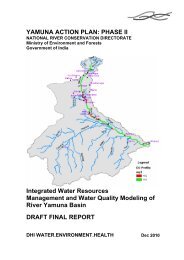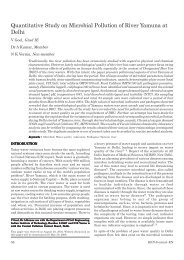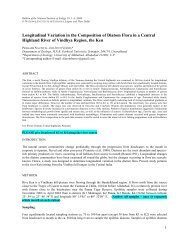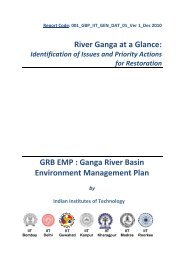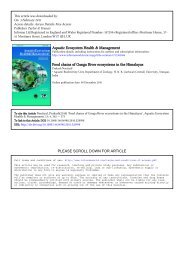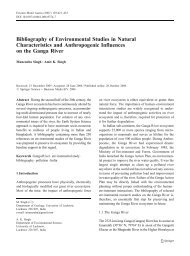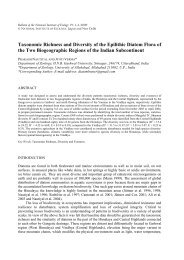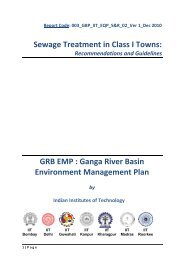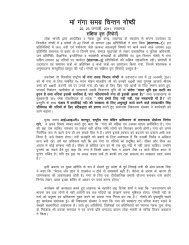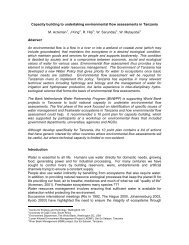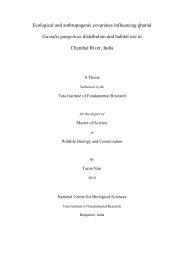JNNURM - GANGAPEDIA
JNNURM - GANGAPEDIA
JNNURM - GANGAPEDIA
You also want an ePaper? Increase the reach of your titles
YUMPU automatically turns print PDFs into web optimized ePapers that Google loves.
City Development Plan for Agra City in the state of Uttar Pradesh under <strong>JNNURM</strong><br />
2.3 PHYSICAL CHARACTERISTICS<br />
The river Yamuna enters the city from the north-east corner, flows towards south for some<br />
distance and then turns towards east. The general slope is from west to east in CIS-Yamuna<br />
area on the right bank of the river Yamuna.<br />
The climate of Agra city is extreme and tropical. During summer season the maximum<br />
temperature of the city rises to 47 0 C and drops down to minimum of 3 0 C during winter<br />
season. The city receives moderate to high rainfall with an average yearly rainfall of about<br />
686mm. The ground levels at Agra vary from RL 150 m to 170m. The strata consist of mainly<br />
sandy soil. The sub-soil water level is generally 6 to 8m below ground level.<br />
The HFL of Agra City is 154.76m at Jawahar Bridge. The city stretches for about 9.0 kms<br />
along the Yamuna river. The major part of the city is on the Western side of Yamuna and has<br />
grown beyond the river on the eastern side and is called the Trans Yamuna area while the<br />
original part is called as CIS Yamuna.<br />
2.4 KEY FEATURES<br />
Agra is ranked amongst the most outstanding historic cities in the world and certainly best<br />
known tourist destinations in India. The city boasts three World Heritage Sites namely – the<br />
Taj Mahal, Fatehpur Sikri & Agra Fort and innumerable other monuments of national and<br />
indeed international importance.<br />
The population of the city as<br />
per Census 2001 is 12,17,534<br />
inhabiting an area of 141.0<br />
sqkm. The city is divided into<br />
80 wards (Map 1). For a city<br />
with million plus population that<br />
has grown at more than 25% in<br />
last thirty years, the<br />
infrastructure<br />
development has failed to keep<br />
pace with population growth.<br />
The city of Agra has several<br />
such deficiencies and there is<br />
a need to make substantial<br />
improvement in basic<br />
infrastructure prevailing in the<br />
city to raise the standard of<br />
health, sanitation, urban<br />
environment keeping pace with rapid urbanization and growing population. The importance of<br />
Agra city as a leading tourist destination has to be kept in view while designing the system to<br />
make the city beautiful, attractive to the tourists visiting the city.<br />
2.5 AGRA MASTER PLAN<br />
City Agra<br />
District Agra<br />
-13-<br />
MDP Consultants in association with Allianz Securities Ltd<br />
Table 2.1: Salient Features Of Agra<br />
Area 141.0 sq. km<br />
Altitude 169m (height above sea level)<br />
Latitude 27° -10'N<br />
Longitude 78° - 02' E<br />
Population 1275134 (as per Census 2001)<br />
Connectivity Air: Nearest airport is Agra<br />
Road: Delhi (200 km); Lucknow (378 km);<br />
Mathura (56 km)<br />
Regional<br />
significance<br />
It is one of the most important tourist<br />
destinations with the proud possession of<br />
“Taj Mahal” as one of the seven wonders of<br />
the world. Agra has a rich historical<br />
background, which is amptly evident from<br />
the numerous historical monuments in and<br />
around the city.



